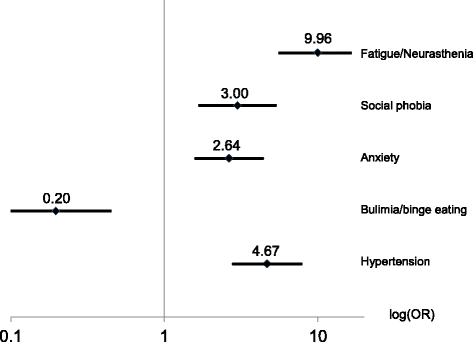Epidemiology of gastrointestinal symptoms in young and middle-aged Swiss adults: prevalences and comorbidities in a longitudinal population cohort over 28 years
- PMID: 29374473
- PMCID: PMC5787318
- DOI: 10.1186/s12876-018-0749-3
Epidemiology of gastrointestinal symptoms in young and middle-aged Swiss adults: prevalences and comorbidities in a longitudinal population cohort over 28 years
Abstract
Background: Although subacute and chronic gastrointestinal symptoms are very common in primary care, epidemiological date are sparse. The aim of the study was to examine and quantify the prevalence of subacute and chronic gastrointestinal symptoms and their associations with somatic and mental disorders in the general population.
Methods: Data were collected prospectively between 1981 (age m = 22, f = 23) and 2008 (age 49/50) from the Zurich Cohort Study (n = 292 men, 299 women), a representative general population survey. The participants were assessed using a semi-structured interview, the "Structured Psychopathological Interview and Rating of the Social Consequences of Psychological Disturbances for Epidemiology" (SPIKE). Prevalence rates were computed to be representative of the general population aged 22-50. Associations were quantified by odds ratios (ORs) and their 99% confidence intervals (CI).
Results: The prevalences of intestinal and of gastric symptoms were significantly higher among women in all categories examined. For example, any gastric symptoms: f. 26.4% vs m.15.2%; any intestinal symptoms: 27.6% vs 14.6%; nausea/vomitus: 19.1% vs 4.5%; constipation: 15.8% vs 6.5% (all p < 0.001). Strong associations (all p < 0.0001) were found between fatigue (1 month) and chronic stomach (OR = 9.96, 99%-CI: 5.53-17.94) and chronic intestinal symptoms (OR = 9.02, 99%-CI: 4.92-16.54). Panic attacks were associated with subacute intestinal symptoms (OR = 4.00, 99%-CI: 2.43-6.59). Anxiety was more strongly associated with subacute intestinal symptoms (OR = 3.37, 99%-CI: 2.23-5.08) than with subacute stomach symptoms (OR = 1.85, 1.20-2.86). Bipolar disorders were associated with subacute stomach symptoms (OR = 1.83, 1.18-2.17) and unipolar depression with subacute intestinal symptoms (OR = 2.05, 1.34-3.15).
Conclusions: Remarkably high prevalence rates of gastric and intestinal complaints were observed in women (over 1/4; men 1/7). Fatigue/neurasthenia was the strongest co-factor in both conditions. Various syndromes related to anxiety, phobia, and panic disorders showed further significant associations. The integration of psychiatric and/or psychological treatment could help address the functional part of gastric and intestinal syndromes.
Keywords: Associations; Epidemiology; Functional; Gastrointestinal; General population survey; Odds ratios; Prevalence.
Conflict of interest statement
Ethics approval and consent to participate
The authors assert that all procedures contributing to this work comply with the ethical standards of the relevant national and institutional committees on human experimentation and with the Helsinki Declaration of 1975, as revised in 2008. The project received prior approval (1978) from the Ethical Committee of the Zurich University Psychiatric Hospital, University of Zurich, Zurich, Switzerland. Informed consent was obtained from all participants.
Consent for publication
Written informed consent to publish results of the assessed data at congresses and in peer-reviewed journals was obtained from all participants.
Competing interests
The authors declare that they have no competing interests.
Publisher’s Note
Springer Nature remains neutral with regard to jurisdictional claims in published maps and institutional affiliations.
Figures




References
MeSH terms
LinkOut - more resources
Full Text Sources
Other Literature Sources
Medical

